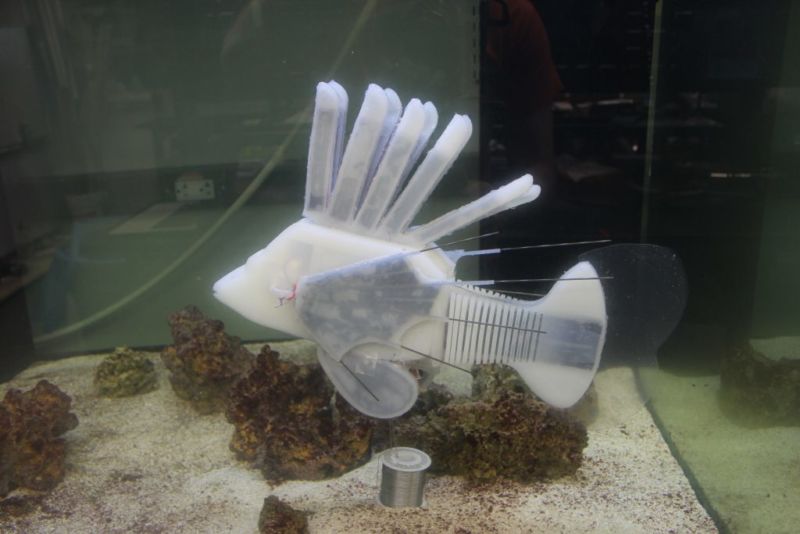
James Pikul
Lots of experimental robots involve a little bit of cheating. Rather than containing all the necessary electronics and energy sources, they have tethers and wires that provide power and control without weighing the robot down or taking up too much internal space. This is especially true for soft-bodied robots, which typically pump air or fluids to drive their motion. Having to incorporate a power source, pumps, and a reservoir of gas or liquid would significantly increase the weight and complexity of the robot.
A team from Cornell University has now demonstrated a clever twist that cuts down on the weight and density of all of this by figuring out how to get one of the materials to perform two functions. Like other soft robot designs, it pumps a fluid to cause its structure to expand and contract, powering movements. But in this case, the fluid is also the key component of a flow battery that powers the pumps. This allows them to put all the critical components on board their creation.
Going with the flow
So what’s a flow battery? Batteries operate by having different reactions that take place at their two electrodes. For something like a lithium-ion battery, the intermediaries of these reactions—electrons and ions—immediately flow from one electrode to another, and the key chemicals spend almost all their time at the electrodes. In flow batteries, the chemical reactions still take place at the electrodes, but the chemicals reside in solution, rather than being confined to electrodes.
Since solutions have limits to how concentrated they can get, this approach tends to limit the energy density of flow batteries, putting most chemistries well below what we can achieve with lithium-ion batteries. But they have one big advantage: energy storage is only limited by how much liquid you can store. That makes flow batteries great for situations where the energy density doesn’t matter, like storing renewable energy for use on the grid.
In this case, the authors would undoubtedly have loved to have the sort of energy density that lithium-ion provides. But the liquid component of a flow battery allowed them to up the energy density in another way. Soft-bodied robots, as their name implies, don’t have the sort of hard skeletons that typical robotic actuators can push against. Instead, their locomotion depends on the coordinated expansion and contraction of different body segments. By expanding the top surface while contracting the bottom surface, a flat robot can move along like an inchworm, to give one example.
This is managed by pumping some sort of fluid—either liquid or gas—into or out of flexible body compartments; the changes in pressure can drive the expansions and contractions needed. That makes the soft-bodied robot a perfect match for the fluid used in flow batteries. The Cornell team draws an analogy between the fluid and blood, as it can run through all the robot’s segments and carry energy to them, both as hydraulic force and as a chemical source of electricity.
The details
That’s the idea at least. How was it implemented? To cut down on the weight issues involved with having fluid flowing around against gravity, the researchers decided to make a swimming robot, modeled on a fish. But not just any fish—a lionfish, which has elaborate dorsal and pectoral fins and can perform displays using them.
The dorsal fins weren’t articulated in this robot; instead, they’re largely used for storage of the battery/hydraulic fluid. The pectoral fins (one on either side of the robot’s body) are able to move, and they have a pump dedicated to moving fluid in and out. A second pump drives the swimming, done by filling and emptying sections of the robot’s body. That body also contains on-board electronics (which communicate by bluetooth) and enough empty space that the researchers had to add weight to keep the robot from simply bobbing to the surface.
The robot goes for a swim.
The chambers that fill with the battery/hydraulic fluid to move the fish and pectoral fins also contain the electrodes that allow the battery to function. These are a simple carbon “felt” with nickel wiring, separated by a membrane that keeps the two liquid components from mixing, while allowing ions to cross. The chemistry used for the battery is zinc iodide, which was chosen for a combination of high energy density (in theory, up to half that of current lithium-ion batteries), neutral pH, and low viscosity (important for a hydraulic fluid).
Put it all together, and you have a very slow-moving fish. In a tank with a weak current, the fish can move about one-and-a-half body lengths a minute, propelled by its tail. While that’s quite slow, it has endurance. The authors estimate it could swim for more than 35 hours straight without needing a charge.
This is a first attempt, and the authors identified several problems with their design. For example, the capacity of the battery starts fading after just 10 cycles, in part because some of the battery solution starts being absorbed by the silicon body of the fish. Since the design was too buoyant, it should be possible to add some additional power by storing more battery fluid in the robot. The researchers also suggest that it would be more efficient to avoid reversing the pump and instead redirect the flow of fluid using a valve in the plumbing.
And of course, the design could be simplified and made more efficient if the pectoral fin display and all the hardware that supports it were eliminated. But that’s not really the point; after all, the whole thing could be made far more efficient by replacing the whole design with a lithium-ion battery and a propeller. But there may eventually be things we specifically want robots of this type for, and this hardware shows a clever way of squeezing better performance out of them.
Nature, 2019. DOI: 10.1038/s41586-019-1313-1 (About DOIs).
Không có nhận xét nào:
Đăng nhận xét